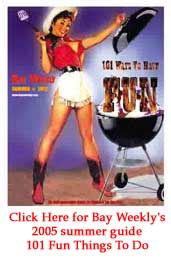 |
Dr. Gouin's Bay Gardener |
 Bagworms Are Feasting
Bagworms Are Feasting
Catch these buggers now before they demand drastic measures
Bagworms are tiny insects that love to feast on arborvitae, pine, spruce, fir, chamaecyparis, hemlock, junipers and other narrow leaf evergreens. When they run out of these species, they will turn to maples, oaks, mulberry, willow, etc. In numbers, bagworms can disfigure and kill plants.
With all of the rain this spring, new growth is soft and succulent, making ideal conditions for bagworms to feed and grow. Each insect is enlarging and building its protective bag. If you watch the bag closely for a few minutes, you can see it wiggle and move along the needles or branches as the worm feeds.
Their conical sacks can best be seen hanging on the underside of branches in late summer and fall, but by the time you notice them, it may too late to control them. They are best controlled now when the bags are less than three-quarters of an inch long.
The safest and most effective means of controlling bagworms now is to spray with Dipel or BT. Both materials are ecologically safe to use. Once the bags increase in size to three-quarters of an inch or longer, biological sprays are no longer effective.
To control larger bagworms you must use Sevin, which is considered a hard pesticide. Bagworms with sacs longer than one and one-quarter inch are almost impossible to kill even with Sevin, at which point the only effective means of control is hand-picking and placing the bags in kerosene or charcoal lighter fluid.
If you had a few bagworms on your trees and shrubs last year, you can anticipate many more this year. So inspect your plants now and take immediate action so you can use safe and effective biological control methods.
Professor Emeritus Francis Gouin retired from the University of Maryland, where he was the state’s extension specialist in ornamental horticulture. Follow his column of practical gardening and plant advice every week, only in Bay Weekly. Ask Dr. Gouin your questions at [email protected].




 Bagworms Are Feasting
Bagworms Are Feasting